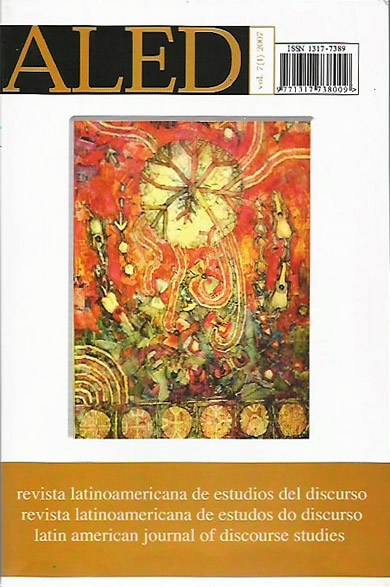Reconstruyendo los paradigmas orientales de los estudios del discurso
Palavras-chave:
estudos do discurso. paradigmas orientais. Análise Crítica do Discurso(ACD). comunidades subalternas. enfoque chinês.Resumo
Em este trabalho explico que existem razões genuínas e condições importantes para reconstruir os paradigmas orientais dos estudos do discurso além dos enfoques atuais, que embora sejam universalistas estão mais centrados no Ocidente. Em primeiro lugar, apresento as limitações e as conseqüências humanas do crescente projeto da Análise Crítica do Discurso (ACD) ocidental. Em segundo lugar, e mais importante, identifico várias características dos discursos de Ásia, África, América Latina e outras comunidades subalternas, assim como seus recursos acadêmicos relevantes. Finalmente, para ilustrar as estratégias de este trabalho de reconstrução, considero as maneiras de forjar um enfoque chinês para analisar discursos tanto próprios quanto globais.
Downloads
Referências
ASANTE, M. K. (1998). The Afrocentric Idea. Revised and expanded ed. Philadelphia: Temple University Press.
BRADY, A-M. (2002). Regimenting the public mind: the modernisation ofpropaganda in the PRC. International Journal. 57 (4): 563-78.
CAREY, J.W. (1992). Communication as Culture: Essays on media and society. NewYork: Routledge.
CHEN G-M. (2004). The two faces of Chinese communication. HumanCommunication. 7: 25-36.
CHEN, G-M (2006). Asian communication studies: what and where to now. TheReview of Communication. 6 (4): 295-311.
CHEN G-M & W. J. STAROSTA (2003). Asian approaches to human communication:a dialogue. Intercultural Communication Studies. XII (4): 1-15.
CHESEBRO, J. (1996). Unity in diversity: multiculturalism, guilt/victimage, anda new scholarly orientation. Spectra. 32 (12): 10-14.
CHU, L.L. (1989). “In search of an Oriental communication perspective”, enChristian Academy (ed.). Continuity and Change in Communications in Post-Industrial Society, pp. 2-14. Seoul: Wooseok Publishing Co.
DISSANAYAKE, W. (ed.) (1988). Communication theory: The Asian perspective.Singapore: Asian Mass Communication Research and Information Center.
DISSANAYAKE, W. (2003). Asian approaches to human communication: retrospectand prospect. Intercultural Communication Studies. XII (4): 16-37.
FAIRCLOUGH, N. (1992). Discourse and Social Change. Cambridge: Polity Press.FANON, F. (1986). Black Skin, White Masks. Trans. C. L. Markmann. London:Pluto Press.
GERGEN, K. (1999). An Invitation to Social Construction. London: SagePublications.
GORDON, R. (1999). A spectrum of scholars: multicultural diversity and humancommunication theory. Human Communication. 2 (1): 1-8.
HEISEY, D. R. (ed.) (2000). Chinese Perspectives in Rhetoric and Communication.Stamford, CT: Ablex.
HIDALGO, M. (ed.) Mexican Indigenous Languages at the Dawn of the Twenty FirstCentury. The Hague: Mouton.
HORNBERGER, N. H. (ed.) Indigenous Literacies in the Americas: Language Planningfrom the Bottom Up. Berlin: Mouton de Gruyter.
ISHII, S. (2001). An emerging rationale for Triworld communication studies fromBuddhist perspectives. Human Communication, 4 (1): 1-10.
LAUF, E. (2005). “National diversity of major international journals in the fieldof communication”. Journal of Communication, March: 139-51.
LIN, A. N. (2001). “The great firewall”. Recuperado en 02/01/07: http://www.cpj.org/Briefings/2001/China_jan01/Great_Firewall.pdf.
LIU, Y. (1996). “To capture the essence of Chinese rhetoric: Anatomy of aparadigm in comparative rhetoric”, Rhetoric Review. 14 (1): 318-34.
KINCAID, D. L. (ed.) (1987). Communication Theory: Eastern and Westernperspectives. San Diego, CA: Academic Press.
MARTIN, J.N. & T.K. NAKAYAMA (2006). “Communication as Raced”, en G.J.Shepherd, J. St. John & T. Striphas (eds.), Communication as””: perspectiveson theory, pp. 75-83. London: Sage Publications.
MIIKE, Y. (2004). “Rethinking humanity, culture, and communication: Asiacentriccritiques and contributions”. Human Communication, 7 (1): 69-82.
MIIKE, Y. (2006). “Non-western theory in western research? An Asiacentricagenda for Asian communication studies”, The Review of Communication,6 (1/2): 4-31.
SHI-XU (2005). A Cultural Approach to Discourse. Houndmills/New York: PalgraveMacmillan.
SHI-XU (2006a). “Editorial: researching multicultural discourses”. Journal ofMulticultural Discourses. 1(1): 1-5.
SHI-XU (2006b). “A multiculturalist approach to discourse theory”. Semiótica.158 (1/4): 383-400.
SHI-XU (ed.) (2007). Discourse as Cultural Struggle. Hong Kong: Hong KongUniversity Press.
SHUTER, R. (2000). “Ethnics, culture, and communication: an interculturalperspective”, en L. A. Samovar & R. E. Porter (eds.), Intercultural Communication: A reader, pp. 443-50. Belmont, CA: Wadsworth PublishingCompany.
SPIVAK, G. C. (1988). In Other Words: Essays in cultural politics. New York:Routledge
STRATTON, J. & I. ANG (1996). “On the impossibility of a global cultural studies:‘British’ cultural studies in an ‘international’ frame”, en D. Morley & K-H.Chen (eds.), Stuart Hall, pp. 361-91.London: Routledge.
VAN DIJK, T. A. (1997). The Study of Discourse. Discourse Studies: a Multidisciplinary Introduction. Vol.1. pp. 1-34. London: Sage.
Downloads
Publicado
Como Citar
Edição
Seção
Licença

Este trabalho está licenciado sob uma licença Creative Commons Attribution-NonCommercial-NoDerivatives 4.0 International License.
Os/As autores/as conservam os direitos autorais e garantem a RALED o direito de ser a primeira publicação do trabalho licenciado por uma Creative Commons Attribution License que permite compartilhar o trabalho com reconhecimento de sua autoria e a publicação inicial nesta revista.




